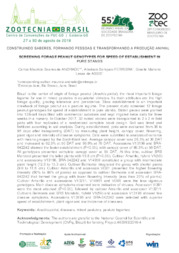Screening forage peanut genotypes for speed of establishment in pure stands.
Screening forage peanut genotypes for speed of establishment in pure stands.
Author(s): ANDRADE, C. M. S. de; FERREIRA, A. S.; ASSIS, G. M. L. de
Summary: Brazil is the center of origin of forage peanut (Arachis pintoi), the most important forage legume for use in mixed pastures in equatorial climates. Its main attributes are the high forage quality, grazing tolerance and persistence. Slow establishment is an important drawback of forage peanut as a pasture legume. The present study screened 12 forage peanut genotypes for speed of establishment in pure stands.
Publication year: 2018
Types of publication: Abstract in annals or event proceedings
Unit: Embrapa Acre
Keywords: Amendoim forrageiro, Arachis pintoi, Cacahuetes forrajeros, Comportamento de Variedade, Ensayos de variedades, Estolones, Forage grasses, Forage legumes, Forage peanut, Gramínea Forrageira, Leguminosa Forrageira, Leguminosas forrajeras, Mixed grazing, Pastagem Mista, Pastoreo mixto, Pastos forrajeros, Pure stands, Rodales puros, Stolons, Variety trials
Observation
Some of Embrapa's publications are published as ePub files. To read them, use or download one of the following free software options to your computer or mobile device. Android: Google Play Books; IOS: iBooks; Windows and Linux: Calibre.
Access other publications
Access the Agricultural Research Database (BDPA) to consult Embrapa's full library collection and records.
Visit Embrapa Bookstore to purchase books and other publications sold by Embrapa.

